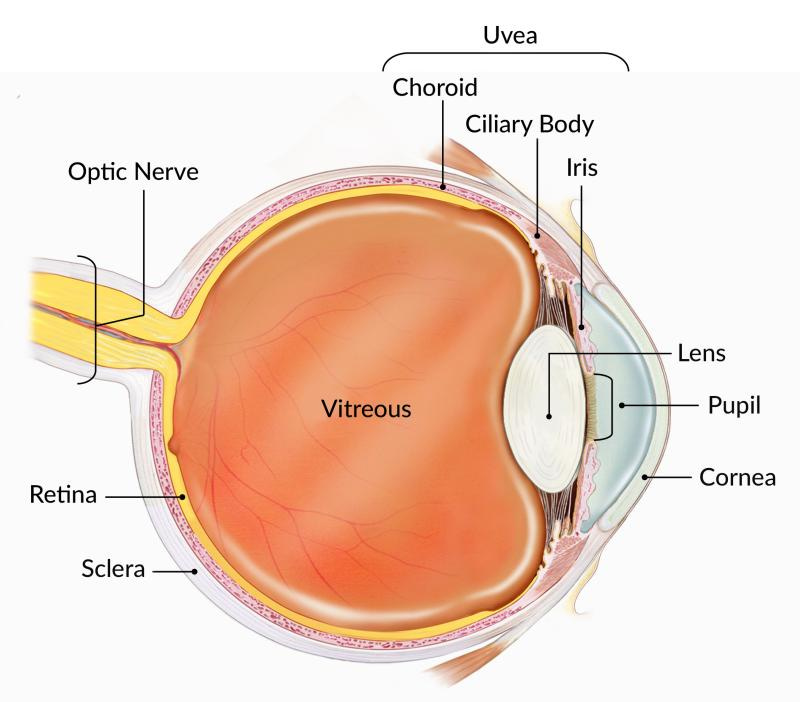Hey there! Have you ever wondered how your eyes work? Well, get ready for a mind- blowing tour of the eye’s inner workings. Buckle up – because we’re about to dive into a “visionary” world!
First things first – let’s start with the eye’s anatomy. Your eye is like a complex team with different players, each with its own important role. At the front line, you’ve got the crystalline lens and transparent cornea, working together to focus incoming light. And not to forget the iris – the coloured part of your eye, controlling the amount of light that gets in by changing the size of the pupil.
Now, let’s zoom in on the star of the show — the retina. It’s located at the back of your eye and has layers upon layers of cells. But here’s the fun part – there are special cells called rods and cones that capture the light. Cones are all about colour vision and seeing fine details in bright light, while rods are the heroes of low-light situations. Talk about teamwork!
Once the light is captured, it’s showtime for the photoreceptor cells. They have light- sensitive pigments that react when exposed to light, triggering a series of electrical impulses. These impulses then pass through a network of cells, like a relay race, until they reach the ganglion cells.
But wait, there’s more! The ganglion cells and their long, thin extensions form the optic nerve. It’s like a superhighway that transports all those electrical impulses to the brain for processing and interpretation. And here’s a mind-boggling fact: the right half of what you see goes to the left hemisphere of your brain, and vice versa. It’s like your brain is playing a game of catch with your eyes!
Now, let’s shift gears and talk about how your brain works its magic. When the electrical impulses reach the brain, they make a pit stop at the thalamus, specifically the lateral geniculate nucleus. Think of it as a pit crew that fine-tunes the signals before passing them on to the main visual cortex.
This cortex is like the master interpreter, analyzing all the signals and creating the beautiful visual tapestry you see before you. It’s like your brain is the ultimate artist, painting a masterpiece of the world around you!
But hold on, we’re not done yet. Your brain doesn’t just rely on your eyes for visual input. It also combines information from other senses, like touch and hearing, to create a complete picture of your surroundings. It’s like throwing a fantastic party in your brain and inviting all the senses!
Why Should You Choose Healthcare Polyclinic For All Your Eye Care Needs?
Well, because we’re the eye care experts who understand the importance of your vision. From comprehensive eye exams to refractive corrections and surgical interventions, we’ve got you covered. Our team of skilled ophthalmologists will ensure your eyes receive the VIP treatment they deserve! You can visit our website at www.healthcare.com.sa or call us at 966138085111
FAQs
Yes, a number of eye problems and illnesses can impair eyesight. Cataracts,
glaucoma, macular degeneration, and diabetic retinopathy are a few typical examples.
Early detection and routine eye examinations are essential for preserving eye health.
When the cornea is excessively curved or the eyeball is too long, nearsightedness
results, blurring the vision of distant objects. When the cornea is too flat or the eyeball is
too short, it causes farsightedness, which causes adjacent things to appear hazy.
lenses?
Yes, refractive faults may be corrected with glasses and contact lenses by changing
how light enters the eye. They assist in correcting nearsightedness, farsightedness,
astigmatism, and presbyopia by focusing light onto the retina.
Regular eye checkups, wearing sunglasses to shield the eyes from UV radiation,
practising excellent eye hygiene, eating a balanced diet full of eye-healthy nutrients, and
quitting smoking are all part of maintaining good eye health.
Depending on the underlying reason, vision loss or blindness may be reversible.
Gene therapy and retinal implants, for example, have given some medical situations
hope, but more comprehensive treatment options are still in the works.
The eye is like a superstar organ, finely tuned to capture and process light so we can experience the wonder of vision. It’s a team effort, with all these structures and cells working together like a well-oiled machine. From the cornea to the retina, they’re on a mission to deliver visual information straight to our brains. And trust me, our brain knows how to turn those signals into mind-blowing visual sensations. It’s like having our very own blockbuster movie playing in our heads!
At Healthcare Polyclinic, we’re all about top-notch eye care in Dammam. Our ophthalmologists are experts in their field, and we’ve got state-of-the-art facilities that will make your eyes go wide with awe. You can visit our website at www.healthcare.com.sa or call us at 966138085111
And the best part? We put our patients at the centre of everything we do.
Head on over to Healthcare Polyclinic and discover the true value of comprehensive eye treatment. Our skilled ophthalmologists are ready to work their magic and keep your priceless gift of sight in tip-top shape. So, don’t wait around—make that appointment and let’s give your eyes the star treatment they deserve.

